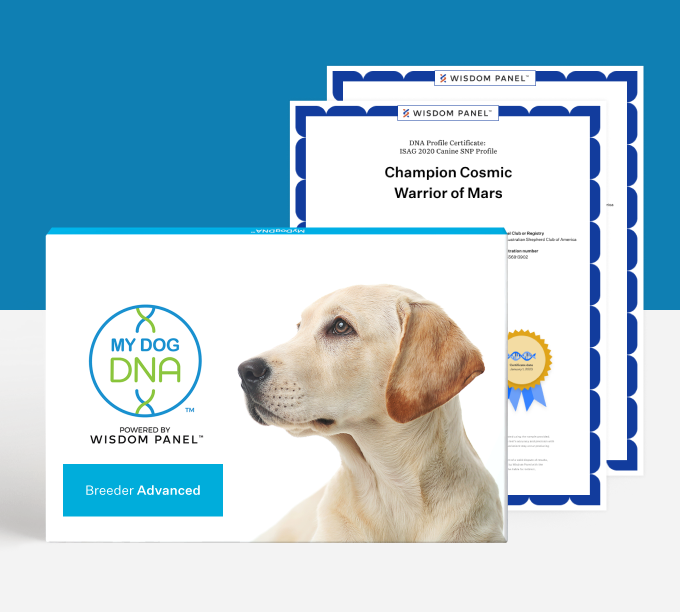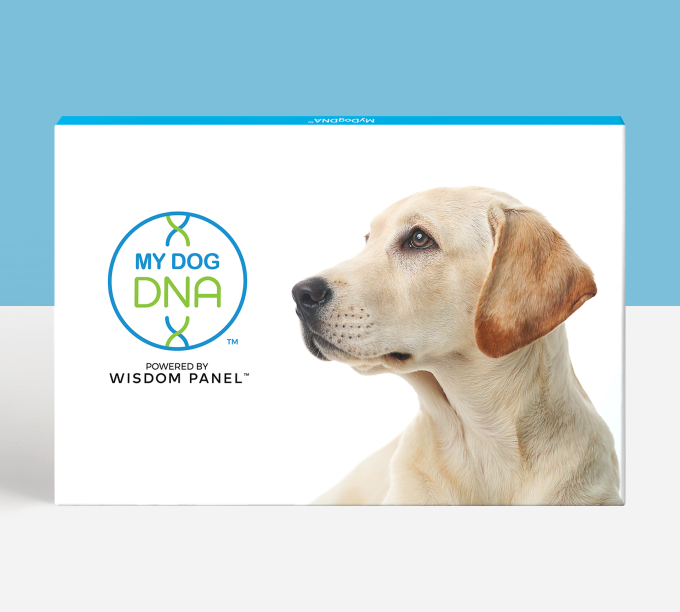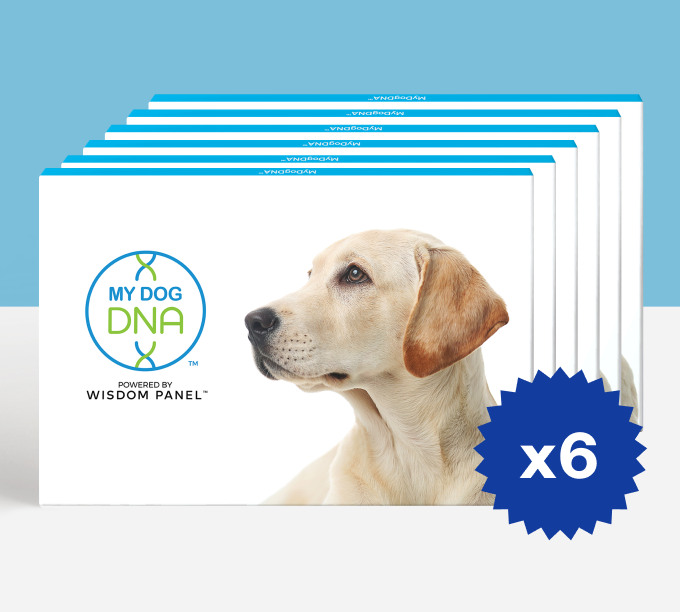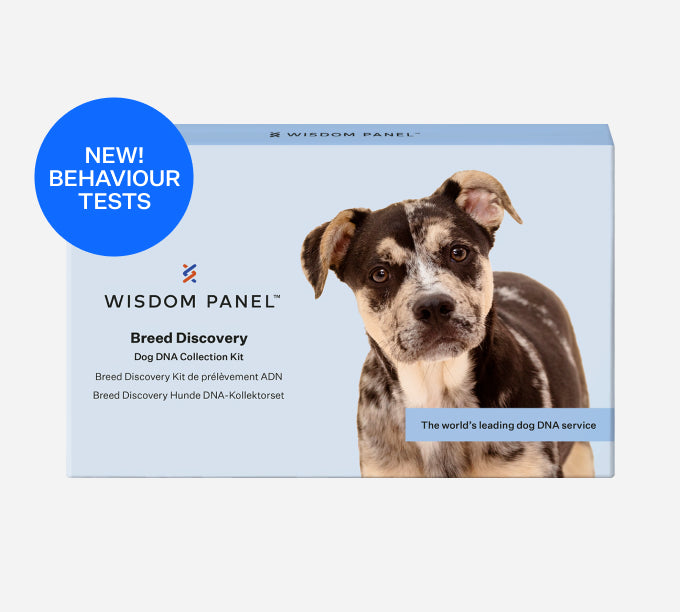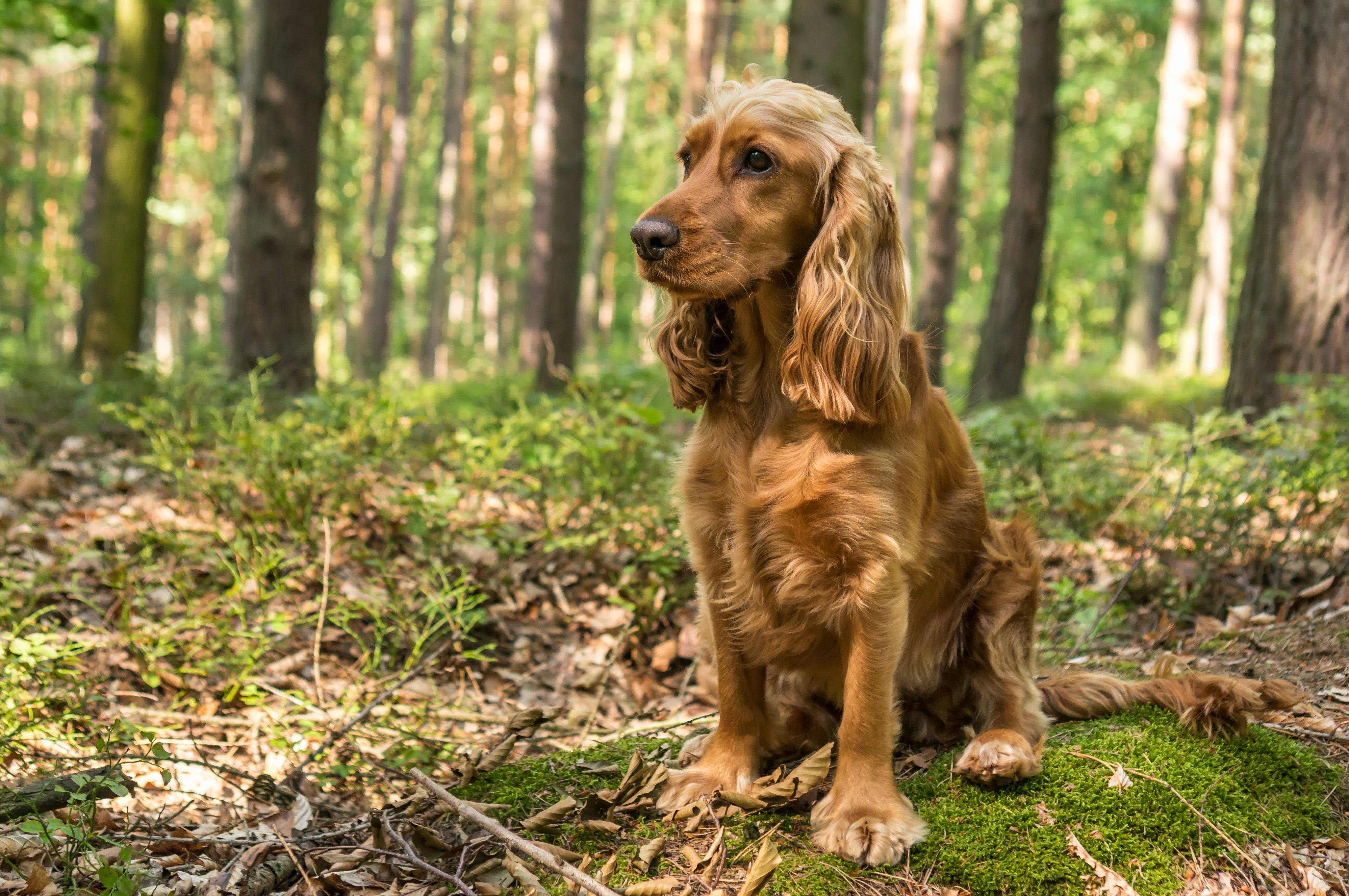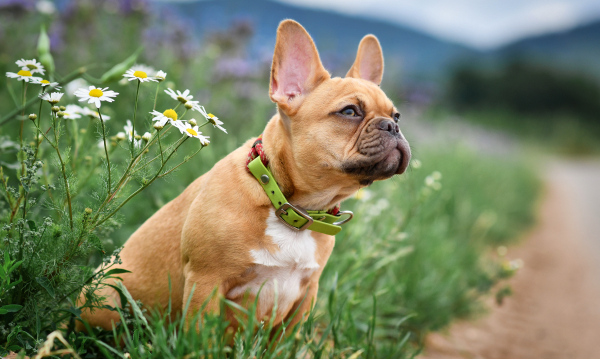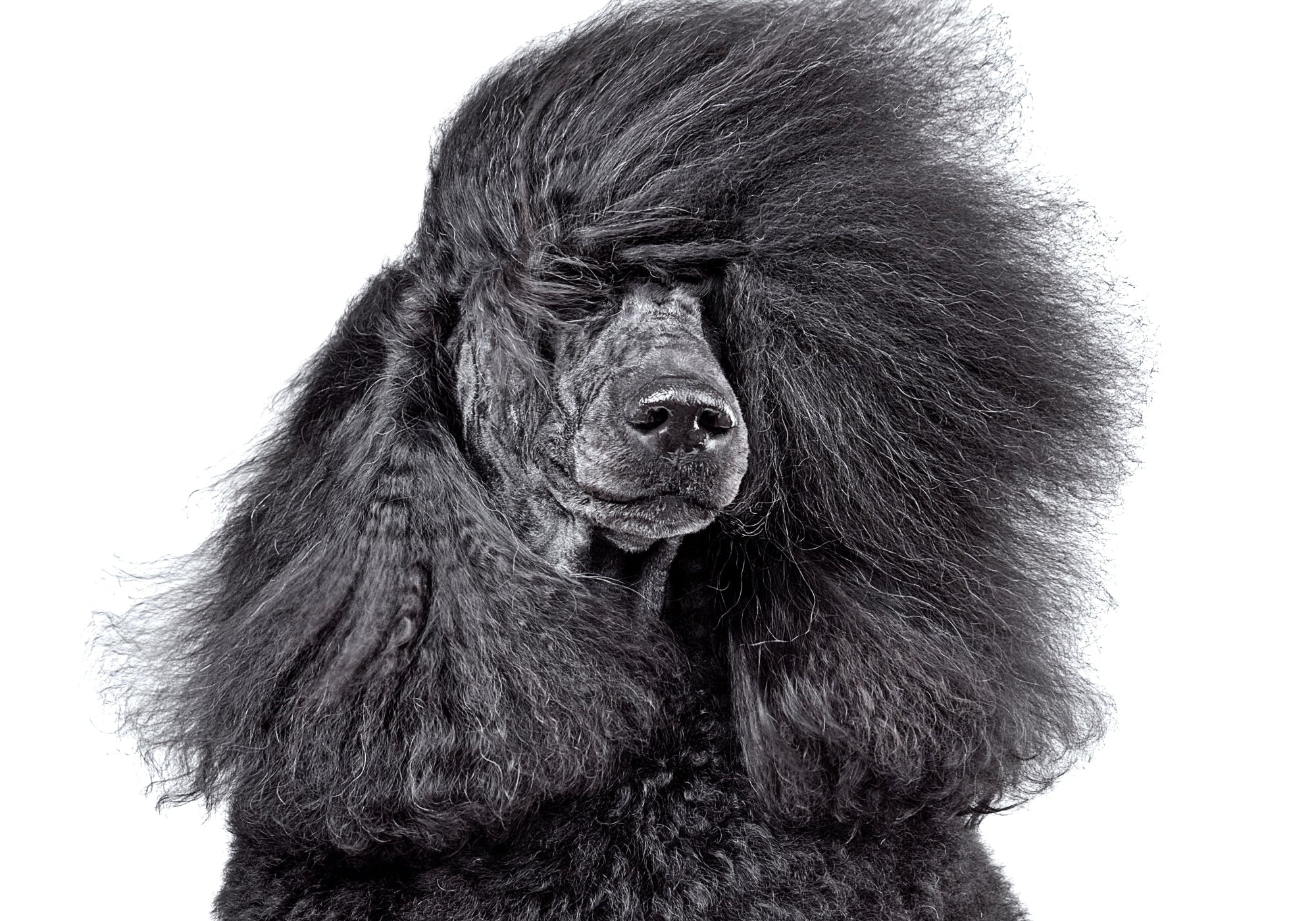In late March of 2023, Wisdom Panel™ added an important new test—Chondrodystrophy (CDDY) and Intervertebral Disc Disease (IVDD) Risk—to its breeder products. This variant is the most common finding across all purebred breeds in our testing, and has both desirable physical trait effects and unwanted health risks. Researchers think this risk factor became enriched in certain breeds for its influence on the conformation of the dog, and the health risks appear to vary by breed. Read on to learn more about this complex disorder and trait.
Many genes are associated with short stature
There are several known genetic mutations which cause shortened stature in dogs. Several are included in MyDogDNA™ and Optimal Selection™ Canine testing. Some cause serious illness, while others are primarily cosmetic in effect. Short-legged dogs have existed for at least 4,000 years, suggesting this trait is very old, and likely arose spontaneously in several breeds over the centuries. In humans, chondrodysplasia is the most common form of dwarfism and occurs in about one in 27,500 people. A dominant mutation in the FGF3 gene is the most common cause. Although FGF4 mutations are more common in dogs, in both species usually the head and trunk are unaffected, but long bones of the legs are thicker and shortened. The most widely recognised short-legged variant in dogs is “breed-defining chondrodysplasia” (CDPA), which has been argued as a beneficial trait in many breeds for performing their historical function. Wisdom Panel™ breeder products include the following genes associated with shortened legs:
- Chondrodysplasia (Discovered in Norwegian Elkhound and Karelian Bear Dog) (ITGA10)
- Disproportionate Dwarfism (Discovered in the Dogo Argentino) (PRKG2)
- Short Legs (Chondrodysplasia, CDPA) (FGF4L1)
- Chondrodystrophy (CDDY) and Intervertebral Disc Disease (IVDD) Risk (FGF4L2)
- Osteochondrodysplasia (Discovered in the Miniature Poodle) (SLC13A1)
- Osteochondromatosis (Discovered in the American Staffordshire Terrier) (EXT2)
- Skeletal Dysplasia 2 (Discovered in the Labrador Retriever) (COL11A2)
Some of these variants are reported in MyDogDNA™ and Optimal Selection™ Canine as disorder findings due to their association with other health effects, some are listed as both a disorder and a trait, and some are categorised as a trait, as they are not known to cause any health risks.

Breed-defining Chondrodysplasia (CDPA)
Chondrodystrophy and chondrodysplasia are equivalent medical terms, and denote a skeletal disorder characterised by disproportionate growth, especially shortened long bones of the legs. "Breed defining chondrodysplasia,” or CDPA, is caused by a retrogene of the FGF4 gene. Two copies of the FGF4 gene are normally present in all dogs, and are important during embryonic development, directing the growth and maturation of the skeleton. Retrogenes are extra copies of a gene, which may be inserted elsewhere in the dog's genome, causing an increased “dosage” of the resulting protein. In other words, when extra FGF4 gene copies are present, extra protein is produced. As it was the first FGF4 variant discovered, the CDPA variant is also called FGF4L1 to differentiate it from the normally-present FGF4 gene. It is located in chromosome 18. CDPA is not known to have any negative health effects in purebred dogs, but the extra copies of FGF4 result in early closure of the growth plates of the long bones.
Dogs with 1 copy of FGF4L1 (CDPA) are estimated to have 16-23% shorter legs, and 24-28% shorter legs if 2 copies are inherited.
Because the growth plates close at different times in dogs with CDPA, in the paired bones of the front legs the ulna closes first, causing the radius to twist around it, like the stringing of a bow. This gives what has been aptly described as the “Elizabethan chair leg” look to the front legs of dogs with the CDPA variant.
 Bavarian Mountain Hounds or Bayerischer Gebirgsschweißhunde showing variable leg length due to CDDY
Bavarian Mountain Hounds or Bayerischer Gebirgsschweißhunde showing variable leg length due to CDDY
Chondrodystrophy (CDDY) as a trait
Chondrodystrophy (CDDY) with intervertebral disc disease (IVDD) risk is also associated with an FGF4 retrogene variant, but in chromosome 12 instead of chromosome 18. For unclear reasons, the environment of that chromosomal location causes a very different expression for CDDY compared to CDPA, even though both are FGF4 retrogenes. CDDY and CDPA both follow a semi-dominant mode of inheritance as a trait. This means dogs with one copy of the genetic variant typically have slight shortening of their legs, whereas dogs with two copies will show a bit more obvious shortening. Unlike CDPA, which causes marked shortening of the limbs but no significant health risks, CDDY causes mild limb shortening with additional effects on the spine.
Researchers estimate that one copy of CDDY causes approximately 6% limb shortening, and 2 copies cause 10% - with very little twisting of the paired long bones, giving the impression of compactness, but not necessarily dwarfism.
CDDY causes other physical effects as well, such as broadening of the head and enlargement of the ear flaps (pinnae), leading researchers to believe it was likely enriched in certain breed groups by breeders of the past to fulfill historic breed purposes. For example, scent hound breeds are known for ear flap (pinnal) enlargement, which helps stir up the dust and direct the scent trail to the dog’s nose for better odour detection. Most importantly, in addition to these historically desirable traits, CDDY also drastically changes the structure and maturation of the discs of the spine. The link to intervertebral disc disease risk was not discovered until research published in 2017, as it does not follow simple patterns of inheritance as for the physical trait effects of CDDY. Additionally, there are several breeds that carry both CDPA and CDDY, and those breeds are known to have the shortest legs of all dog breeds. Common breeds for this include the Dachshund (all varieties), Welsh corgis (Pembroke and Cardigan), Pekingese, and Basset Hound.
Changes in body shape based on CDDY and CDPA copy number, increases in size/length are to the right of the dotted line, decrease in size/length are to the left of the line. FGF4L1 = CDPA, FGF4L2=CDDY. From Bannasch D, Batcher K, et al. The Effects of FGF4 Retrogenes on Canine Morphology. Genes (Basel). 2022.
Intervertebral Disc Disease (IVDD)
The anatomy of the dog’s spine is similar to that of humans, with the bones of the back, called vertebrae, separated by cushions called intervertebral discs. The discs themselves have an outer fibrous ring, and a central soft “cushion” to allow flexibility and shock absorption for the spine. Veterinarians have long recognized that there are two very distinct presentations of dogs that have spinal disc disease, dubbing them Hansen’s type I and Hansen’s type II intervertebral disc disease (IVDD):
-
Hansen’s type I: most common in younger dogs (aged 3-6), and breeds with short legs. Usually there is bony degeneration (calcification) of the discs, and often multiple discs are affected
-
Hansen’s type II: most common in older dogs (aged 8-10 years), and larger breeds. Often only one or two discs are affected.
With the discovery of the CDDY variant, it was found that CDDY is present in the majority of dogs with Hansen’s type I IVDD. Degeneration and calcification of the intervertebral discs is a process known as intervertebral disc disease (IVDD). With degeneration and calcification of the discs, affected dogs are at risk for intervertebral disc herniation, which is a painful and sometimes life-threatening condition.
Chondrodystrophy (CDDY) as a disorder risk
Dogs with one or two copies of the CDDY variant are likely to experience premature degeneration and calcification of the intervertebral discs, so the disorder risk is considered to follow a dominant mode of inheritance. The most important clinical risk for dogs with IVDD secondary to this variant is intervertebral disc herniation (IVDH). However, it is worth noting that this variant is a risk factor for disc herniation, and some dogs with one, or even two, copies of this variant may not go on to show clinical signs of disc herniation. Additionally, not all dogs affected by IVDD have the CDDY-associated gene variant, particularly dogs with Hansen’s type II IVDD, indicating additional genetic or environmental causes for spinal disc disease.
 Herniation in a Basset Hound in the lumbar spine (between L1-L2). da Costa RC, Canine Spinal Cord Injury Consortium (CANSORT-SCI) et al. Diagnostic Imaging in Intervertebral Disc Disease. Front Vet Sci. 2020
Herniation in a Basset Hound in the lumbar spine (between L1-L2). da Costa RC, Canine Spinal Cord Injury Consortium (CANSORT-SCI) et al. Diagnostic Imaging in Intervertebral Disc Disease. Front Vet Sci. 2020
Intervertebral Disc Herniation (IVDH)
Dogs that inherit the CDDY variant experience associated changes even while in their mother’s womb. Even at 1 week old, these pups can show indications of disproportionate growth, with shorter limbs with an average sized body and head. Puppies who have radiographs (“x-rays”) under 1 year of age may already show calcified discs. It’s this disc degeneration and calcification that predisposes these dogs to disc herniation, or IVDH, during their lifetime. The disc can bulge into the spinal canal, pinching the spinal cord, commonly called a “slipped disc," or the central portion of the disc that has calcified can escape, and act like a bullet to the spinal cord. Increasing numbers of types of herniation are now being recognised, and there are multiple possible spinal locations for herniation, so signs the dog may show, and the degree of nerve function loss, may vary. Many cases of herniation may require surgery to relieve spinal cord pressure and restore nerve function. Indications of changes consistent with IVDD or IVDH—such as narrowed intervertebral disc spaces or the calcification of the discs—may show up on diagnostic imaging, depending on the specifics of the degeneration at that site.
Age at time of herniation diagnosis varies greatly between the different breeds, with the median age of dogs presenting for surgery ranging from 3 to 10 years. Dogs may also experience IVDH in multiple locations during their lifetime. However, as the clinical signs are most often due to spinal cord compression by the disc material, if the disc herniates in a direction that does not involve the spinal cord, such as ventrally (toward the abdomen), these dogs may not appear symptomatic:
Research has shown that asymptomatic (ventral) herniation may occur in 21% of dogs with CDDY-associated disc herniation
For dogs that experience clinical disc disease, one of the initial signs can appear as back pain. This pain is often demonstrated by generalised stiffness or keeping an arched back, shivering or shaking, muscle spasms, hesitation to move, or vocalisation when touched. Key signs of disc herniation that compresses the spinal cord also include lameness, limb weakness, paw knuckling when walking, incoordination when walking (ataxia), or the inability to walk (paralysis). Some dogs may also experience faecal or urinary incontinence. Any of these signs warrant an immediate examination by a veterinarian. The most common location of disc herniation is in the midback, where the ribcage meets the loin, which tends to affect the hind legs, whereas disc herniation in the neck can affect all four limbs. A veterinarian would assess the severity of the spinal cord pinching, as dogs experiencing paralysis without deep pain sensation are the worst affected and have the most guarded prognosis.

Likelihood of herniation
The development of disc disease in dogs is complex and multifactorial, and includes a number of genetic and environmental risk factors. The CDDY and IVDD Risk variant tested by Wisdom is just one of the considerations for understanding a dog’s unique predisposition to disc herniation. Not every dog with one, or even two, copies of the tested variant will go on to show signs of disc herniation.
Dogs with one or two copies of the CDDY-associated variant have been shown to have a 5 to 15 times higher risk of requiring back surgery. Breed background was found to play a significant role in that risk determination.
The risk of IVDH is the highest in the Dachshund, with an estimated 28-31% lifetime risk, depending on the study. More research is needed to understand additional risk factors, and not all breeds have been studied for breed-specific risks. Unfortunately, it’s not possible to completely prevent IVDH for dogs who are predisposed. However, maintaining a lean body weight and healthy musculature are key for any dog that is at risk of disc herniation during their lifetime.
Radiographic screening for IVDH risk
Some kennel and breed clubs have instituted programs to encourage or require spinal radiographs to look for spinal abnormalities, including intervertebral disc calcification (IDC). Across most breeds, the average number of calcified discs appears to be higher in dogs with 2 copies of CDDY than those with 1 copy. However, not all breeds have been thoroughly evaluated for correlation between CDDY genotype, disc calcifications, and herniation risk, and some breeds, such as the French Bulldog, can herniate with very little visible calcification, so additional research is needed.
The number of calcified discs appears to be heritable in Dachshunds, with one study showing that if both parents had calcifications, 91% of their puppies had calcifications, and if one parent had calcifications, only 44% of their puppies had them. The number of calcifications also appears to be related to risk of herniation and back pain in Dachshunds. Several studies have shown that Dachshunds with no visibly calcified discs – grade 0 – have a much lower lifetime risk of back pain and herniation, with some studies reporting a 10% incidence. Grade 3 dogs – those with 5 or more IDCs – were reported to have a 64% incidence. That’s an 18-fold increased odds of signs of IVDD between dogs with no calcifications and those with 5 or more.
What you can do for at-risk dogs now
A healthy weight will prevent undue strain on the spine and other joints, while regular exercise—like uphill walks or swimming—can build strong back muscles to support the spine. On the flip side, it’s best to avoid high-impact activities that could cause twisting or compression of the spine. And, for senior dogs needing a little extra assistance, ramps will allow them to more easily access furniture or get into the car. Stairs may actually decrease the risk of disc herniation, related to maintaining healthy muscling in the back. From the DachsLife study in 2015:
“Analysis identified dogs that exercised for <30 min per day, were not allowed to jump on and off furniture, or were supplemented with glucosamine or chondroitin were at increased odds of IVDD, whereas dogs that exercised for more than 1 h per day, that were considered highly or moderately active by their owners, and those that showed at Open or Championship shows were at decreased odds of IVDD.”
Be sure to discuss any insights uncovered through genetic testing with your veterinarian—including if your dog is considered at an elevated risk for developing disc herniation. Veterinarians are well aware of IVDD risk in certain breeds from clinical experience, but especially in less common breeds, you may need to initiate the conversation.
What you can do in your breeding programme
A study completed by scientists at the Royal Veterinary College, London found that having a long body relative to leg length, in addition to smaller size, may be additional factors in disc herniation risk. This would suggest that breeding for smaller size and for exaggerated back length should be avoided to reduce the risk of IVDH.
In low frequency breeds:
The health risks of CDDY are present if any copies of the variant are inherited, so in breeds with low frequency of the variant, you may choose to breed away from one copy and two copy at-risk dogs. It’s always best to consider the breed diversity when doing so, and take time to decrease frequency of at-risk dogs to retain valuable breed diversity. More than 80 breeds, however, have frequencies over 20%, according to Wisdom Panel™ breeder data. Those breeds warrant a different approach.
In moderate frequency breeds:
In breeds with moderate frequency, it is not reasonable to rely on breeding only clear dogs within the immediate period, as this could create a genetic bottleneck in the breed that could be irreversible. Low genetic diversity comes with its own risks. Instead, many breed groups with moderate frequency are focusing on a combined approach of favoring one copy at-risk dogs or clear dogs if all other factors are equal, and in addition, conducting spinal radiographic screening after age 2. As mentioned earlier, although not all breeds have been studied to confirm association of calcified intervertebral disc number and lifetime risk of herniation, in the absence of this research, a reasonable approach is to avoid breeding dogs with any more than 4 intervertebral disc calcifications.
In high frequency breeds:
More than 50 breeds have allelic frequencies of CDDY over 70%, according to Wisdom Panel™ breeder data. Although not all of these dogs will go on to have signs of intervertebral disc disease or herniation, dogs that are affected experience serious discomfort, so management of IVDD risk is still essential. Radiographic spinal grading and genetic testing to identify 1-copy at-risk and clear dogs are the mainstays of management in high frequency breeds. Screening results change with age, so to have the best idea of intervertebral disc calcification (IDC) grade, spinal radiographs should be taken and reviewed after the dog is 2 years of age. Most registries recommend avoiding breeding dogs with a grade of 3, equivalent to 5 or more calcified discs. In Dachshunds in the UK, this is estimated to be roughly one quarter of the population. And of course, if dogs that are 1-copy at-risk for CDDY are available, judicious use, without overuse of the line, is also possible.
How is disc herniation treated?
Treatment for disc herniation focuses on medical management and/or surgical intervention, with both approaches including strict crate rest. Deciding the type of treatment to pursue involves a number of factors that should be considered on a case-by-case basis. These factors include the speed of onset, severity of condition, proximity to specialised veterinary care, and financial considerations. Similarly, the success of treatment and general prognosis depend on several factors, particularly the severity and duration of signs.
Medical management is most successful in dogs experiencing back pain who are still able to walk independently. Typically, this approach includes weeks of complete activity restriction (crate time) paired with medication to address pain and inflammation. The goal of treatment is to allow plenty of time for a scar to form over the ruptured disc(s), reducing pressure on the spinal cord and preventing future ruptures of additional disc material. Prognosis with medical management can vary greatly depending on the factors of the individual case. And it’s important to note that recurrence can occur, especially if the dog is allowed to return to activity too quickly.
Back surgery, such as a hemilaminectomy, is typically recommended for dogs that cannot walk or those experiencing chronic back pain. The purpose of the procedure is to surgically remove the herniated disc material compressing the spinal cord. Following surgery, weeks of complete activity restriction are necessary for healing. Prognosis following surgery is often good for dogs who cannot walk but can still feel their feet. However, time is of the essence for dogs that cannot walk and cannot feel deep pain, as surgery is only successful in 50% of these cases if surgery is performed within the first 24 hours. After that period, the rate of successful recovery falls dramatically.
Back surgery requires specialised tools and knowledge, so it’s usually performed by veterinary specialists. In addition, advanced imaging techniques, like magnetic resonance imaging (MRI), are needed to pinpoint the exact location of slipped disc(s) for the procedure. Therefore, availability and cost of these services are important considerations.
A look at the statistics
The CDDY and IVDD Risk variant is widespread across the dog population and, to date, has been identified in over 140 breeds through Wisdom Panel™ breeder testing. The data further show that across all dogs, including mixed-breed dogs, 1 in 5 dogs tested have at least one copy of the variant. As noted before, the risk for a dog requiring back surgery due to disc herniation ranges from 5 to 15 times more likely in dogs with one to two copies of this genetic variant.
Breeds with a CDDY variant frequency above 5% based upon global submissions from Optimal Selection and MyDogDNA*:
|
Breed |
Allelic Frequency |
Sample Count |
|
American Cocker Spaniel |
100% |
30-100 |
|
American Water Spaniel |
100% |
<30 |
|
Anglo-Francais de Petite Venerie |
100% |
<30 |
|
Australian Labradoodle |
37% |
30-100 |
|
Barbado da Terceira |
26% |
<30 |
|
Barbet |
10% |
100-500 |
|
Basset Hound |
78% |
30-100 |
|
Bavarian Mountain Hound |
100% |
<30 |
|
Beagle |
99% |
100-500 |
|
Biewer Terrier |
10% |
30-100 |
|
Bolognese |
37% |
<30 |
|
Boykin Spaniel |
69% |
<30 |
|
Buldogue Campeiro |
100% |
<30 |
|
Bulldog (English) |
7% |
100-500 |
|
Cardigan Welsh Corgi |
97% |
100-500 |
|
Cavalier King Charles Spaniel |
99% |
100-500 |
|
Chihuahua |
5% |
100-500 |
|
Chinese Crested |
62% |
100-500 |
|
Clumber Spaniel |
100% |
<30 |
|
Continental Toy Spaniel |
84% |
<30 |
|
Coton de Tulear |
23% |
100-500 |
|
Dachshund |
95% |
100-500 |
|
Dachshund (Miniature Longhaired) |
95% |
100-500 |
|
Dachshund (Miniature Shorthaired) |
94% |
100-500 |
|
Dachshund (Miniature Wirehaired) |
99% |
100-500 |
|
Dachshund (Rabbit Shorthaired) |
100% |
<30 |
|
Dachshund (Rabbit Wirehaired) |
100% |
<30 |
|
Dachshund (Standard Longhaired) |
98% |
30-100 |
|
Dachshund (Standard Shorthaired) |
92% |
<30 |
|
Dachshund (Standard Wirehaired) |
93% |
30-100 |
|
Dandie Dinmont Terrier |
100% |
<30 |
|
Danish-Swedish Farmdog |
12% |
100-500 |
|
Dutch Partridge Dog (Drentsche Patrijshond) |
100% |
<30 |
|
English Cocker Spaniel |
95% |
500-1000 |
|
English Springer Spaniel |
26% |
30-100 |
|
Field Spaniel |
100% |
<30 |
|
French Bulldog |
90% |
>1000 |
|
Hanoverian Scenthound |
100% |
<30 |
|
Havanese |
12% |
100-500 |
|
Kooikerhondje |
65% |
30-100 |
|
Kromfohrlander |
12% |
100-500 |
|
Lhasa Apso |
11% |
30-100 |
|
Maltese |
5% |
30-100 |
|
Markiesje |
71% |
30-100 |
|
Mi-Ki |
9% |
<30 |
|
Miniature Pinscher |
25% |
30-100 |
|
Nova Scotia Duck Tolling Retriever |
26% |
30-100 |
|
Papillon |
93% |
100-500 |
|
Parti Colored Poodle |
44% |
<30 |
|
Pekingese |
60% |
<30 |
|
Pembroke Welsh Corgi |
92% |
100-500 |
|
Poodle (Medium and Standard) |
39% |
100-500 |
|
Poodle (Medium) |
76% |
100-500 |
|
Poodle (Miniature and Toy) |
72% |
100-500 |
|
Poodle (Miniature) |
75% |
100-500 |
|
Poodle (Toy Black) |
96% |
<30 |
|
Poodle (Toy Red/Apricot) |
82% |
<30 |
|
Poodle (Toy) |
72% |
100-500 |
|
Portuguese Water Dog |
10% |
500-1000 |
|
Prague Ratter |
10% |
30-100 |
|
Pyrenean Shepherd |
5% |
30-100 |
|
Russell Terrier |
7% |
30-100 |
|
Russian Toy |
24% |
30-100 |
|
Russian Tsvetnaya Bolonka |
14% |
100-500 |
|
Schapendoes |
39% |
30-100 |
|
Schnauzer (Miniature) |
16% |
100-500 |
|
Shih Tzu |
16% |
30-100 |
|
Spanish Water Dog |
86% |
100-500 |
|
Stabyhoun |
49% |
100-500 |
|
Tibetan Spaniel |
8% |
100-500 |
|
Tibetan Terrier |
19% |
30-100 |
|
Welsh Springer Spaniel |
100% |
<30 |
|
Xoloitzcuintli |
8% |
30-100 |
|
Yorkshire Terrier |
8% |
100-500 |
*Note that these figures may change as additional samples are received, as well as breeder-selection influences frequencies over time. A similar chart can be found at Wisdompanel.com, but does not reflect breeder-only submissions.
References:
Morris, D (2002) Dogs: A Dictionary of Dog Breeds (Trafalgar Square Publishing, North Pomfret, VT).
Parker HG, VonHoldt BM, Quignon P, et al. An expressed FGF4 retrogene is associated with breed-defining chondrodysplasia in domestic dogs. Science (New York, NY) 2009; 325:995-998. doi: 10.1126/science.1173275
Parker HG, VonHoldt BM, Quignon P, et al. An expressed FGF4 retrogene is associated with breed-defining chondrodysplasia in domestic dogs. Science (New York, NY) 2009; Online Supplementals.
Weir, M, Hunter, T and Downing, R. “Cervical Intervertebral Disc Disease in Dogs.” https://vcahospitals.com/know-your-pet/cervical-intervertebral-disk-disease-in-dogs. Updated 2024.
Bannasch D, Batcher K, Leuthard F, Bannasch M, Hug P, Marcellin-Little DJ, Dickinson PJ, Drögemüller M, Drögemüller C, Leeb T. The Effects of FGF4 Retrogenes on Canine Morphology. Genes (Basel). 2022 Feb 10;13(2):325. doi: 10.3390/genes13020325.
Bianchi CA, Marcellin-Little DJ, Dickinson PJ, Garcia TC, Li CF, Batcher K, Bannasch DL. FGF4L2 retrogene copy number is associated with intervertebral disc calcification and vertebral geometry in Nova Scotia Duck Tolling Retrievers. Am J Vet Res. 2023 Jan 26;84(3). doi: 10.2460/ajvr.22.09.0167.
Batcher K, Dickinson P, et al. Phenotypic Effects of FGF4 Retrogenes on Intervertebral Disc Disease in Dogs. Genes (Basel). 2019 Jun 7;10(6):435. doi: 10.3390/genes10060435.
da Costa RC, De Decker S, Lewis MJ, Volk H; Canine Spinal Cord Injury Consortium (CANSORT-SCI). Diagnostic Imaging in Intervertebral Disc Disease. Front Vet Sci. 2020 Oct 22;7:588338. doi: 10.3389/fvets.2020.588338.
Jensen VF, Christensen KA. Inheritance of disc calcification in the dachshund. J Vet Med A Physiol Pathol Clin Med. 2000 Aug;47(6):331-40. doi: 10.1046/j.1439-0442.2000.00297.x.
Lappalainen AK, Vaittinen E, et al. Intervertebral disc disease in Dachshunds radiographically screened for intervertebral disc calcifications. Acta Vet Scand. 2014 Dec 19;56(1):89. doi: 10.1186/s13028-014-0089-4.
Packer RM, Hendricks A, et al. How long and low can you go? Effect of conformation on the risk of thoracolumbar intervertebral disc extrusion in domestic dogs. PLoS One. 2013 Jul 24;8(7):e69650. doi: 10.1371/journal.pone.0069650.
Packer RM, Seath IJ, et al. DachsLife 2015: an investigation of lifestyle associations with the risk of intervertebral disc disease in Dachshunds. Canine Genet Epidemiol. 2016 Nov 5;3:8. doi: 10.1186/s40575-016-0039-8.

